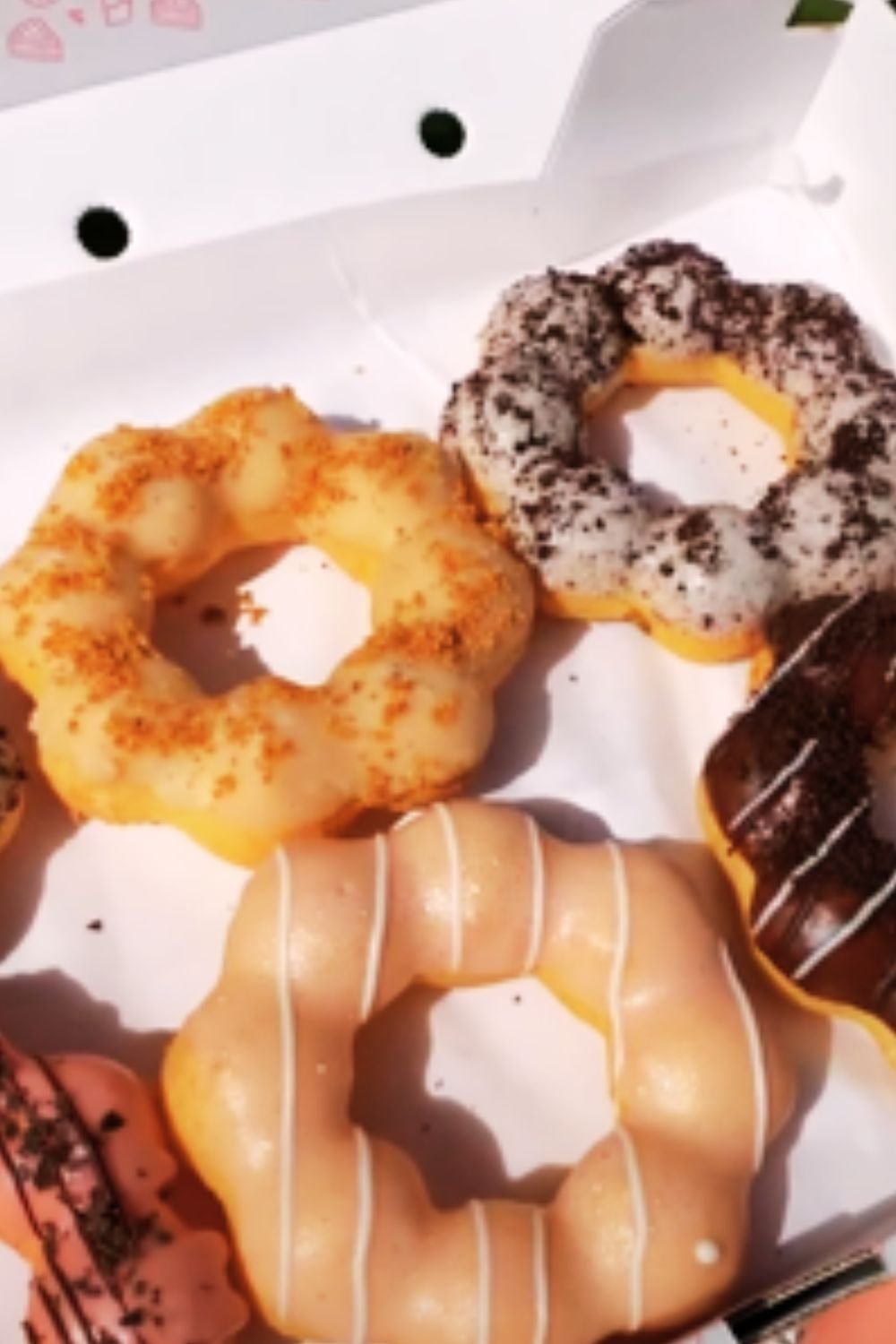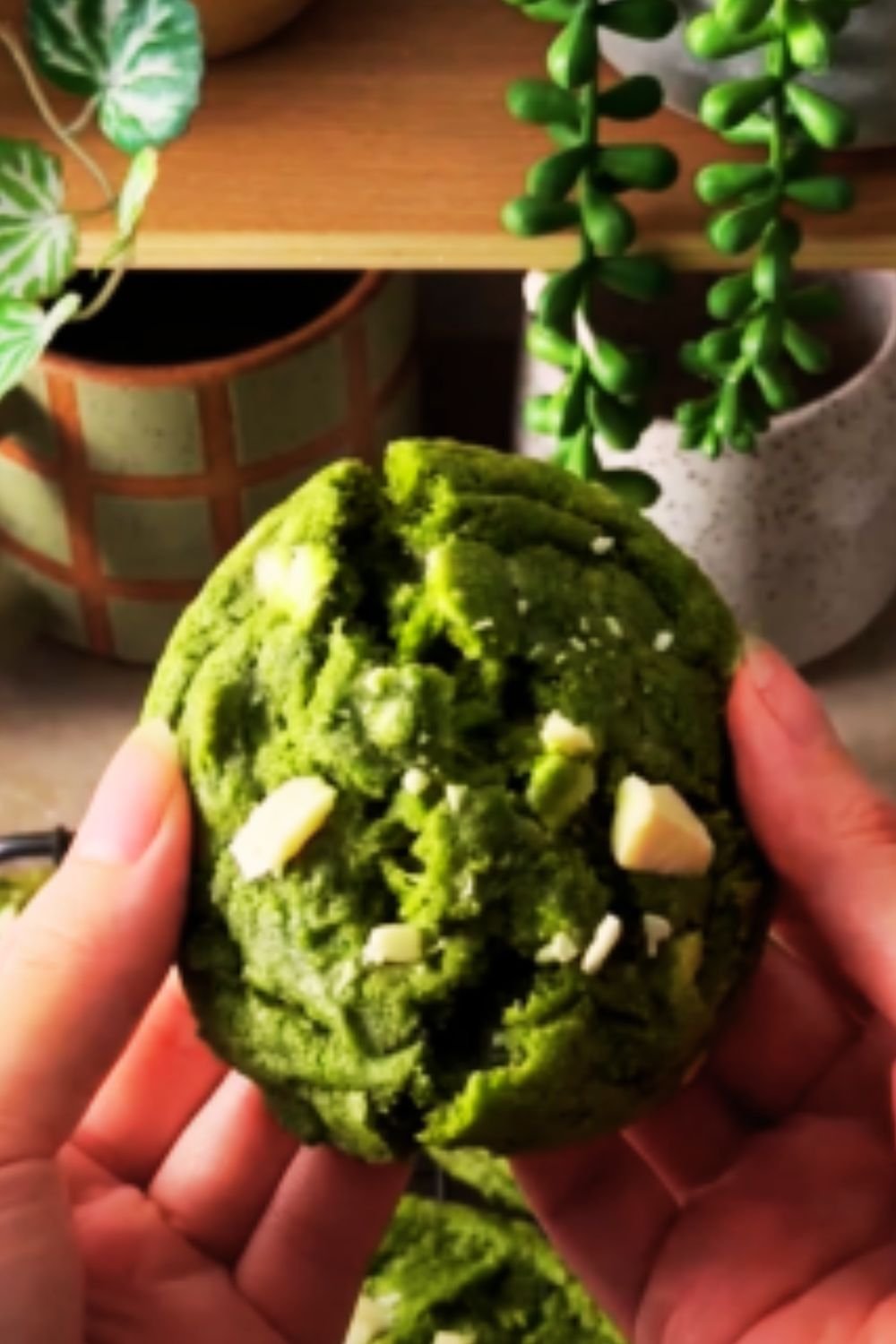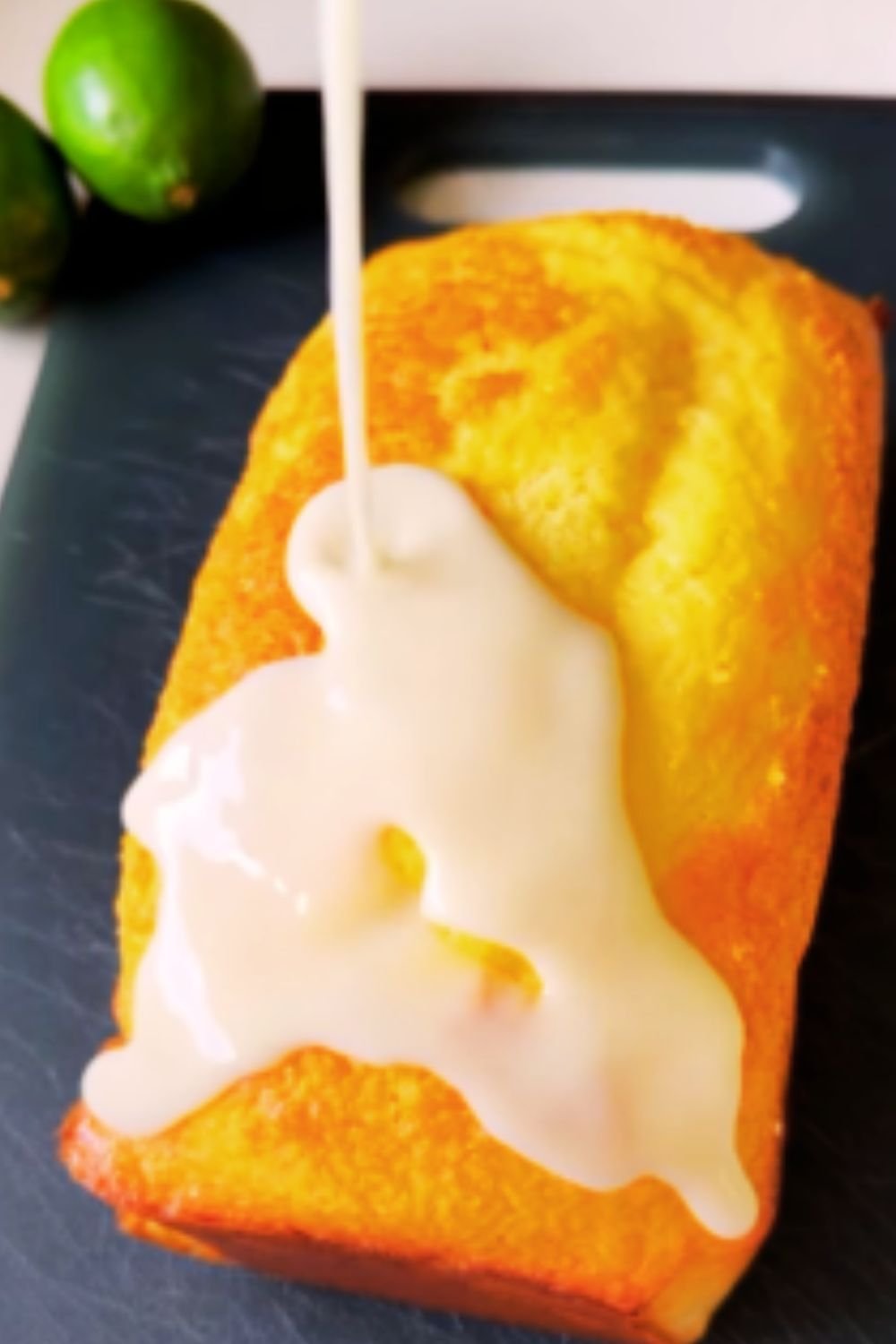There’s something magical about biting into a perfectly chewy mochi donut. The distinctive texture that gently pulls apart, the subtle sweetness, and that beautiful balance of airiness and density—it’s a textural experience unlike any other dessert. When you add the earthy, slightly bitter notes of high-quality matcha powder to the mix, you elevate these treats to something truly special.
I’ve been obsessed with perfecting mochi donuts at home for years, particularly the famous “Pon de Ring” style popularized by Japanese bakeries. The traditional versions are typically deep-fried, but after countless test batches and some kitchen mishaps I’d rather not discuss (let’s just say my smoke detector and I are now well-acquainted), I’ve developed this foolproof baked version that delivers all the chewy goodness without the hassle of deep-frying.
These baked matcha mochi donuts are not only easier to make but also a bit lighter than their fried counterparts. The glutinous rice flour creates that signature chewy texture, while the matcha provides a sophisticated flavor profile that balances the sweetness perfectly. Finished with a simple matcha glaze, these donuts are as visually stunning as they are delicious.
What Makes These Donuts Special
Before diving into the recipe, let’s talk about what makes these donuts truly unique:
Glutinous Rice Flour: The secret to authentic mochi texture : Unlike wheat flour, glutinous rice flour (also called sweet rice flour or mochiko) creates that distinctive chewy, stretchy texture that defines mochi. Despite its name, it contains no gluten and is naturally gluten-free.
Matcha Powder: The star flavor component : I use ceremonial-grade matcha for its vibrant color and complex flavor profile. Culinary-grade works too, but the color and flavor won’t be as pronounced.
Pon de Ring Shape: The iconic connected balls design : This shape isn’t just aesthetically pleasing—it creates more surface area for the glaze and provides the perfect chewy-to-crisp ratio in each bite.
Baking vs. Frying: Healthier and more accessible : Baking these donuts makes them slightly lighter and much easier to prepare at home without specialized equipment.
The Ultimate Baked Matcha Mochi Donuts Recipe
Ingredients
For the Donuts:
- 1 cup (160g) glutinous rice flour (mochiko)
- ½ cup (60g) all-purpose flour
- 2 tablespoons (12g) high-quality matcha powder
- 1½ teaspoons baking powder
- ¼ teaspoon salt
- ½ cup (100g) granulated sugar
- 2 large eggs, room temperature
- ¼ cup (60ml) milk, room temperature
- ¼ cup (60ml) plain yogurt
- 3 tablespoons (45g) unsalted butter, melted and cooled
- 1 teaspoon vanilla extract
For the Matcha Glaze:
- 1 cup (120g) powdered sugar, sifted
- 1 tablespoon matcha powder
- 2-3 tablespoons milk or heavy cream
- ½ teaspoon vanilla extract (optional)
Optional Toppings:
- Crushed pistachios
- Dried rose petals
- White chocolate drizzle
- Black sesame seeds
- Freeze-dried strawberry powder
Equipment Needed:
- Donut baking pan (preferred) or silicone molds
- Piping bag with large round tip (or zip-top bag with corner cut)
- Mixing bowls
- Whisk and spatula
- Cooling rack
- Small offset spatula for glazing
Instructions
Prepare the Donut Batter:
- Preheat your oven to 350°F (175°C). Generously grease your donut pan with cooking spray or butter.
- In a medium bowl, whisk together the glutinous rice flour, all-purpose flour, matcha powder, baking powder, and salt until well combined and no green matcha lumps remain.
- In a separate large bowl, whisk the sugar and eggs until light and slightly increased in volume, about 2 minutes by hand or 1 minute with an electric mixer.
- Add the milk, yogurt, melted butter, and vanilla extract to the egg mixture. Whisk until completely smooth and well incorporated.
- Gradually add the dry ingredients to the wet ingredients, folding gently with a spatula until just combined. Be careful not to overmix; the batter should be thick but smooth.
- Transfer the batter to a piping bag fitted with a round tip or a zip-top bag with a corner snipped off.
For Traditional Donuts:
- Pipe the batter into the prepared donut pan, filling each cavity about ¾ full.
For Pon de Ring Style:
- To create the signature Pon de Ring shape, pipe small connected balls of batter in a circle formation in each donut cavity. Each donut will require about 8 small dollops of batter positioned in a ring.
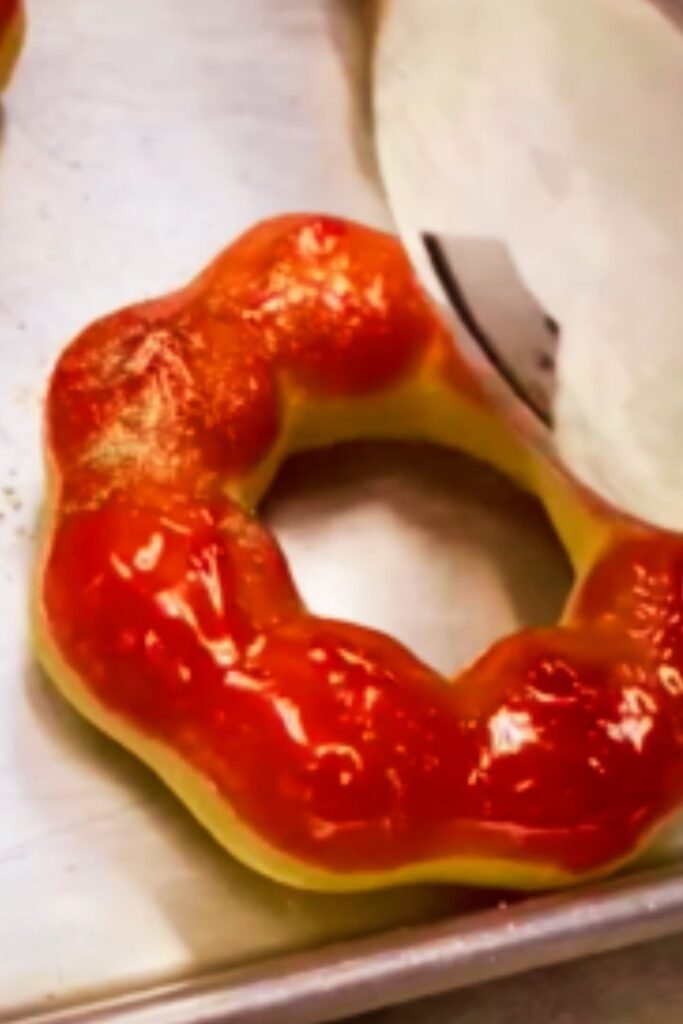
Baking:
- Tap the pan gently against the counter a few times to remove any air bubbles.
- Bake in the preheated oven for 12-15 minutes, or until the donuts are puffy and spring back when lightly touched. The tops should be just set but not browned.
- Remove from the oven and allow to cool in the pan for 5 minutes before carefully transferring to a wire rack to cool completely.
Prepare the Matcha Glaze:
- In a shallow bowl wide enough to dip the donuts, whisk together the sifted powdered sugar and matcha powder.
- Gradually add milk or cream, one tablespoon at a time, whisking constantly until you achieve a smooth glaze with a thick but dippable consistency. Add vanilla extract if using.
- If the glaze is too thick, add more milk a teaspoon at a time. If too thin, add a bit more powdered sugar.
Glaze the Donuts:
- Once the donuts are completely cool, dip the top of each donut into the glaze, allowing excess to drip back into the bowl.
- Place glazed donuts back on the cooling rack, and immediately sprinkle with your chosen toppings before the glaze sets.
- Allow the glaze to set for about 15-20 minutes before serving.
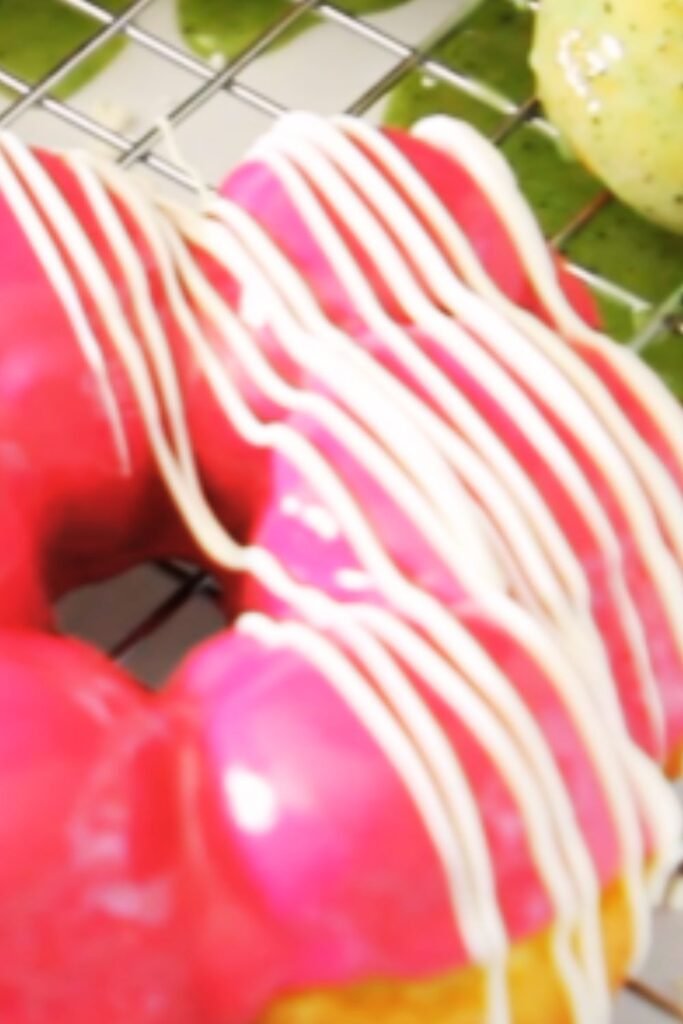
Expert Tips for Perfect Matcha Mochi Donuts
After countless batches (and a few memorable failures), I’ve gathered some essential tips to ensure your matcha mochi donuts turn out perfectly every time:
- Room temperature ingredients: This ensures proper mixing and even baking. Cold eggs or milk can cause the melted butter to solidify prematurely.
- Sift your dry ingredients: Matcha powder tends to clump, so sifting ensures even distribution of color and flavor throughout your donuts.
- Don’t overmix: Stop folding as soon as the ingredients are combined. Overmixing can develop the gluten in the all-purpose flour, resulting in tougher donuts.
- Use a scale if possible: For the most consistent results, measuring ingredients by weight rather than volume is always more accurate, especially for flour.
- The right matcha matters: Lower quality matcha can taste bitter and won’t give you that vibrant green color. Invest in good matcha powder for the best flavor and appearance.
- Let them cool completely: The texture of mochi donuts continues to develop as they cool. They might seem too soft right out of the oven, but they’ll firm up to the perfect chewy consistency once cooled.
- Glaze while still slightly warm: For the best coverage, the donuts should be cool enough to handle but still slightly warm when glazed.
Troubleshooting Common Issues
Even with a solid recipe, things don’t always go as planned. Here are solutions to common mochi donut problems:
| Issue | Possible Cause | Solution |
|---|---|---|
| Donuts too dense | Too much flour or overmixing | Measure flour carefully and mix just until combined |
| Donuts not chewy enough | Wrong type of rice flour | Ensure you’re using glutinous rice flour (mochiko), not regular rice flour |
| Glaze too runny | Too much liquid added | Add more powdered sugar gradually until desired consistency is reached |
| Glaze too thick | Not enough liquid | Add milk/cream ½ teaspoon at a time until spreadable |
| Donuts stick to the pan | Pan not greased well enough | Use non-stick cooking spray generously or try silicone molds |
| Dull green color | Low-quality matcha or overmixing with heat | Use higher grade matcha and ensure ingredients aren’t too warm when mixing |
Storing and Serving Suggestions
Mochi donuts are best enjoyed fresh on the day they’re made, but properly stored, they can last a bit longer:
- Day of baking: Absolute peak texture and flavor.
- Room temperature: Store in an airtight container for up to 24 hours.
- Refrigerator: Keep for up to 3 days in an airtight container. Bring to room temperature before serving for best texture.
- Freezer: Freeze unglazed donuts for up to 1 month. Thaw at room temperature and glaze before serving.
Perfect Pairings:
These matcha mochi donuts pair beautifully with:
- Genmaicha or hojicha tea
- Cold brew coffee
- Vanilla almond milk
- Traditional matcha latte
- Hot chocolate with a dash of cinnamon
Variations to Try
Once you’ve mastered the basic recipe, get creative with these delicious variations:
Black Sesame Mochi Donuts
Replace the matcha powder with 3 tablespoons of finely ground black sesame seeds and reduce sugar to ⅓ cup for a nutty, less sweet version.
Ube Mochi Donuts
Substitute matcha powder with 3 tablespoons of ube powder or ¼ cup of ube paste (reduce milk accordingly if using paste).
Mango Coconut Mochi Donuts
Omit the matcha, replace regular milk with coconut milk, and add 1 teaspoon of mango extract. Glaze with a simple mango puree and powdered sugar glaze.
Chocolate Mochi Donuts
Replace matcha powder with 3 tablespoons of high-quality cocoa powder and add an extra tablespoon of sugar to balance the bitterness.
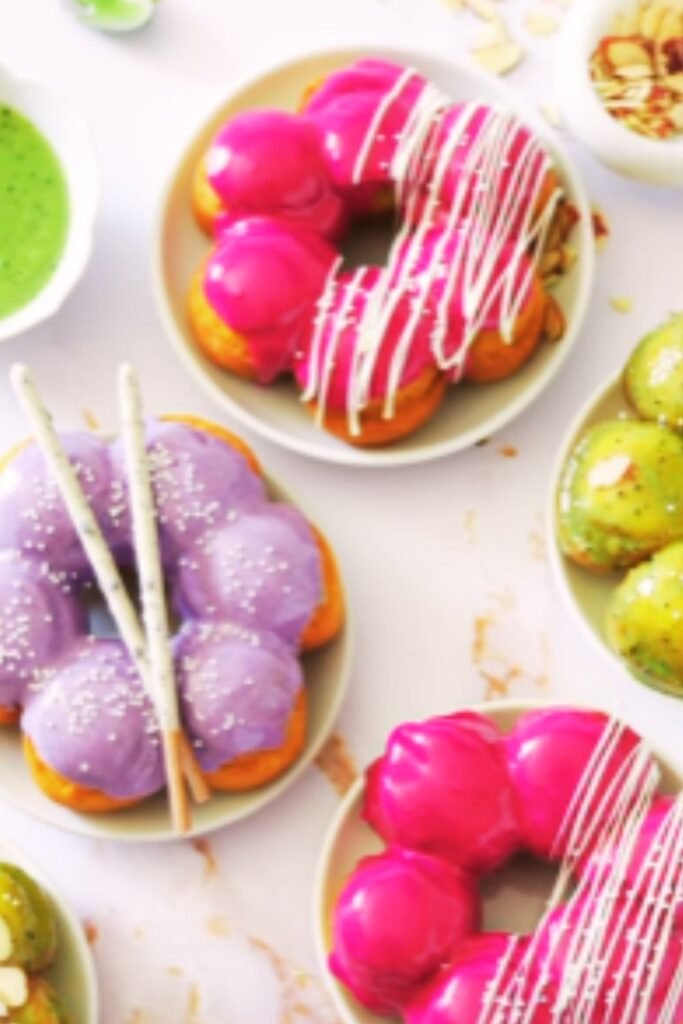
The Cultural Significance of Mochi Donuts
Mochi donuts, particularly the Pon de Ring style, represent a fascinating culinary fusion. Traditional Japanese mochi (pounded sticky rice cakes) have been reimagined in donut form, combining Eastern and Western dessert traditions.
The Pon de Ring style specifically originated in Japan at the Mister Donut chain, where they became an instant sensation for their unique appearance and delightful texture. The name “Pon de” is actually inspired by a type of Brazilian cheese bread called “Pão de Queijo,” which shares a similar chewy texture.
In recent years, mochi donuts have gained immense popularity globally, particularly in urban centers with vibrant Asian food scenes. They exemplify the creative cultural exchange that happens when traditional ingredients meet new cooking techniques and aesthetic sensibilities.
By making these matcha mochi donuts at home, you’re participating in this delicious cultural conversation—and creating something that honors both tradition and innovation.
Health Benefits of Matcha
While I wouldn’t exactly call donuts a health food, the addition of matcha does bring some nutritional benefits to these treats:
- Antioxidants: Matcha is extraordinarily rich in catechins, a class of plant compounds that act as natural antioxidants.
- L-theanine: This amino acid promotes relaxation without drowsiness and may help improve focus.
- Chlorophyll: The high chlorophyll content contributes to matcha’s vibrant green color and detoxifying properties.
- Moderate caffeine: Matcha provides a gentler energy boost than coffee, with effects that typically last longer without the crash.
When enjoyed as an occasional treat, these matcha mochi donuts can be part of a balanced approach to eating that includes both nutrition and pleasure.
Frequently Asked Questions
Q: Can I make these completely gluten-free? Yes! Simply replace the all-purpose flour with a gluten-free all-purpose flour blend that contains xanthan gum. The texture might be slightly different, but they’ll still be delicious.
Q: I can’t find glutinous rice flour. Can I use something else? Unfortunately, there’s no perfect substitute that will give you the same chewy mochi texture. Some have tried tapioca flour with partial success, but I’d recommend ordering glutinous rice flour online if you can’t find it locally.
Q: How do I know when the donuts are done baking? They should be puffy and spring back when gently pressed with a finger. The tops should be set but not browned. A toothpick inserted should come out clean or with just a few moist crumbs.
Q: Can I make these without a donut pan? Yes! You can use silicone molds or even make “donut holes” by piping small rounds of batter onto a parchment-lined baking sheet. Just adjust the baking time accordingly (donut holes will bake faster).
Q: Why did my donuts deflate after baking? This usually happens when they’re underbaked or when the oven door is opened too early in the baking process. Make sure to check for doneness carefully and avoid opening the oven during the first 10 minutes of baking.
Q: My glaze is lumpy. What did I do wrong? Always sift your powdered sugar and matcha before mixing the glaze. If you still have lumps, strain the mixture through a fine-mesh sieve or whisk vigorously until smooth.
Q: Can I make the batter ahead of time? I don’t recommend it. The baking powder activates once liquid is added, so for the best rise, the batter should be baked soon after mixing. You can, however, measure out all dry ingredients the day before.
Final Thoughts
Creating these baked matcha mochi donuts at home might seem intimidating at first, but I promise the process is both manageable and rewarding. There’s something deeply satisfying about mastering this unique texture and watching friends and family experience that first magical bite.
What I love most about this recipe is how it brings together tradition and innovation—honoring the ancient art of mochi-making while reimagining it in a contemporary, accessible form. The addition of matcha not only provides a stunning color but also adds complexity to the flavor profile that elevates these treats beyond ordinary donuts.
Whether you’re an experienced baker looking for a new challenge or simply a matcha enthusiast eager to expand your repertoire, these baked matcha mochi donuts are sure to become a new favorite. Happy baking!
